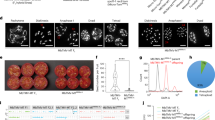Abstract
It is generally thought that apomictic asexual reproduction produces offspring identical to the parent. In this paper we report changes that occur within a generation by selection on less than 25 offspring of an atypical strain of the aphid Myzus persicae starting from a single parthenogenetic mother. These changes consist of variations in the amount of a particular esterase (E4). The amount of this enzyme has already been shown to be correlated with levels of resistance to insecticides in different strains of this aphid1, and it has also been shown that E4 binds and hydrolyses the activated form of the insecticide parathion2. Recombination between homologous chromosomes has been eliminated as the source of variation and it appears that gene amplification might be one explanation of this phenomenon. It is conceivable that this phenomenon is associated with rapid evolutionary events such as the evolution of resistance to insecticides.
This is a preview of subscription content, access via your institution
Access options
Subscribe to this journal
Receive 51 print issues and online access
$199.00 per year
only $3.90 per issue
Buy this article
- Purchase on Springer Link
- Instant access to full article PDF
Prices may be subject to local taxes which are calculated during checkout
Similar content being viewed by others
References
Devonshire, A. L. Proc. 8th Br. Insecticide Fungicide Conf. 1, 67–73 (1975).
Devonshire, A. L. Biochem. J. 167, 675–683 (1977).
Blackman, R. L., Takada, H. & Kawakami, K. Nature 271, 450–452 (1978).
Beranek, A. P. Entomologia exp. appl. 17, 381–390 (1974).
Devonshire, A. L. & Sawicki, R. M. Nature 280, 140–141 (1979).
Cognetti, G. Experientia 17, 168–169 (1961).
Blackman, R. L. Biol. J. Linnean Soc. 11, 259–277 (1979).
Hansche, P. E., Beres, V. & Lange, P. Genetics 88, 673–687 (1978).
Anderson, R. P. & Roth, J. R. A. Rev. Microbiol. 31, 473–506 (1977).
Alt, F. W., Kellems, R. E., Bertino, J. R. & Schimke, R. T. J. biol. Chem. 253, 1357–1370 (1978).
Normark, S., Edlund, T., Grundstrom, S. & Wolf-Watz, H. J. Bact. 132, 912–922 (1977).
Author information
Authors and Affiliations
Rights and permissions
About this article
Cite this article
Bunting, S., Van Emden, H. Rapid response to selection for increased esterase activity on small populations of an apomictic clone of Myzus persicae. Nature 285, 502–503 (1980). https://doi.org/10.1038/285502a0
Received:
Accepted:
Issue Date:
DOI: https://doi.org/10.1038/285502a0
This article is cited by
-
Rapid response to intraclonal selection in the pea aphid (Acyrthosiphon pisum)
Evolutionary Ecology (1995)
-
Genetic variation inMeloidogyne incognita virulence against the tomatoMi resistance gene: evidence from isofemale line selection studies
Theoretical and Applied Genetics (1994)
-
The economics of escape behaviour in the pea aphid, Acyrthosiphon pisum
Oecologia (1990)
-
No evidence for frequency-dependent selection acting between clones of the water flea, Daphnia magna
Heredity (1981)
-
The effect of conventional and artificial diet on esterase band pattern inMyzus persicae (Sulzer)
Experientia (1981)
Comments
By submitting a comment you agree to abide by our Terms and Community Guidelines. If you find something abusive or that does not comply with our terms or guidelines please flag it as inappropriate.



